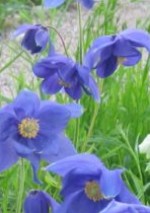 Siberian columbine is a herbaceous perennial native to central Asia and Siberia. It is a member of the buttercup family, Ranunculaceae, that also includes delphinium, anemone, and monkshood. The compact plants have biternate blue-green basal leaves, with arrow leaflets. The nodding to semi-erect flowers appear in the spring and have spreading sepals and very short reflexed spurs. The flowers are bright blue,1 ¾ inches long and give way to small dull black seeds. Plants self-seed but also hybridize easily so seed may not breed true. The variety jacunda is a bit smaller in size and has white petals surrounded by blue sepals. At twelve inches high Siberian columbine is a good choice for the rock garden as well as the front of the border. It is also useful in woodland gardens with dappled shade. The genus name, Aquilegia, may come from the Latin word aquila meaning eagle and refers to the spurs that resemble an eagle’s talons.
Siberian columbine is a herbaceous perennial native to central Asia and Siberia. It is a member of the buttercup family, Ranunculaceae, that also includes delphinium, anemone, and monkshood. The compact plants have biternate blue-green basal leaves, with arrow leaflets. The nodding to semi-erect flowers appear in the spring and have spreading sepals and very short reflexed spurs. The flowers are bright blue,1 ¾ inches long and give way to small dull black seeds. Plants self-seed but also hybridize easily so seed may not breed true. The variety jacunda is a bit smaller in size and has white petals surrounded by blue sepals. At twelve inches high Siberian columbine is a good choice for the rock garden as well as the front of the border. It is also useful in woodland gardens with dappled shade. The genus name, Aquilegia, may come from the Latin word aquila meaning eagle and refers to the spurs that resemble an eagle’s talons.
Type: Herbaceous perennial
Bloom: Bright blue nodding to semi erect flowers with very short reflexed spurs in spring
Size: 12” H x 12” W
Light: Part shade to full sun
Soil: Average, moderately moist, well-drained
Hardiness: Zones 3-8
Care: Deadhead to prolong bloom. Cut down to ground level when foliage becomes ratty to refresh.
Pests and Diseases: Leaf minors, columbine borer
Propagation: Seed
Companion Plants: Cranesbills (Geranium spp.), evening primrose (Oenothera spp.) iris, peonies, Amsonia spp., Baptisia spp., daffodils